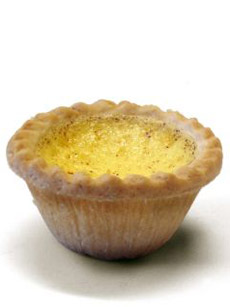
June 2009
Last Updated November 2025
|
 |
Pastry Glossary: Different Kinds Of Pastry
Cobbler & Other Types Of Pastry & Pies
Page 3: Definitions With C
This page contains terms such as cheesecake, cobbler, and custard pie. This is Page 3 of a ten-page glossary. Click the black link below to visit other pages. See our many other food glossaries, each featuring a different favorite food.
CANNOLI
A Sicilian pastry, cannoli is actually the plural form of the word. The singular is cannolo (cannolu in Sicilian dialect), meaning “little tube.” The crunchy, fried pastry dough tube (sometimes dipped in chocolate) is filled with a sweetened ricotta cream (sometimes mascarpone), which can be flavored with vanilla, chocolate, pistachio, marsala, rosewater, and other flavorings. Chocolate chips or candied citron can be mixed into the filling; the open ends of the tube can be decorated with chopped chocolate or pistachio nuts. Cannoli range in size from finger-sized “cannulicchi” (mini-cannoli) to five-inch-long tubes.
You can also find “cannoli tarts,” made with a pie crust, filled with cannoli cream, and generally topped with a strawberry. The history of cannoli.
|
|

Cannoli. Photo by Mike Connors | MorgueFile. |
Today, you can find many flavors of cannoli, and cannoli cream makes a delicious dessert with cookies for dipping.
There are also savory cannoli, typically made by fine chefs—everything from a Buffalo chicken cannoli to whitefish salad and caviar.
National Cannoli Day is celebrated on June 16th, and September is National Cannoli Month.
CATHERINE’S PASTRY
Plain pastry made with pastry flour and the addition of 1/2 teaspoon baking powder. The baking powder makes it almost as flaky as puff pastry. It is an especially good base for cream pie.
CHEESECAKE
A cheesecake is actually a custard pie made in a springform pan. It generally has a bottom crust, although savory cheesecakes are often crustless and are served with crackers as an appetizer or as a first course (see our review of Savory Secret cheesecakes). The weight and texture of a cheesecake varies greatly according to the type of cheese used (cream cheese, ricotta cheese, or cottage cheese, other cheeses for some savory recipes) and other recipe elements. There are light and airy cheesecakes, rich and dense cheesecakes, and everything in between. Crusts can be pastry, cookie crumbs, or bread crumbs. Cheesecakes are made in a rainbow of flavors and are served chilled, plain, or with a variety of toppings, including sour cream, fresh fruit, fruit toppings, and sauces. See cheesecake royale, below.
The history of cheesecake.
CHEESECAKE ROYALE
After the cheesecake comes out of the oven and cools briefly, a topping of sour cream and vanilla is baked on top of it for a final five minutes, creating a separate sour cream layer.
CHEESE PASTRY
Plain pastry with five tablespoons of grated cheese cut in with the shortening. This pastry is an ideal pairing with fruit pies, e.g., a Cheddar crust with apple pie.
|
|
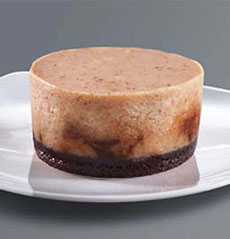
Toffee Crunch Cheesecake from PRPastry.com, maker of many delicious flavors of cheesecake.

An espresso cheesecake topped with chocolate truffles. Here’s the recipe (photo © DeLallo). |
CHEESE STRAWS
Cheese straws are strips of pastry, topped with cheese and baked until crisp. They are sometimes twisted for a more festive shape. Today popular with cocktails, the original cheese straws are believed to be a result of leftover biscuit dough, which was mixed with cheese and rolled into long strips that were baked along with the biscuits to be enjoyed as snacks. There are also sweet cheese straws, flavored with cinnamon, citrus, and other flavors. Read the history of cheese straws.
|
|
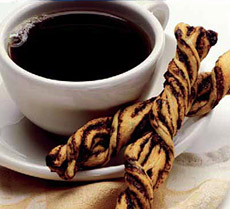
Cinnamon cheese straws from John Wm. Macy’s, a NIBBLE Top Pick Of The Week. |
| CHELSEA BUN
A traditional currant bun, created around 1700 at the Chelsea Bun House in London—an establishment favored by Hanoverian royalty accustomed to similar pastries in their native Germany. They were so popular that there was once a near-riot over supply! You’ll find them commemorated in works by authors such as Charles Dickens and Lewis Carroll, among others. The building was demolished in 1839.
The bun is made of a rich yeast dough flavoured with lemon peel, cinnamon or mixed spices, and rolled with currants. Its American counterpart is the raisin danish.
|
|

Chelsea buns. Here’s the recipe (photo © Sainsbury). |
CHESS PIE
A Southern specialty, chess pie is a simple pie of eggs, butter, sugar, and vanilla with a cornmeal crust. It uses brown sugar in addition to white sugar, and some recipes use corn syrup as well. It is very sweet—like pecan pie without the pecans. The name has nothing to do with the game of chess, but, as this is the simple base for more complex recipes, it may relate to the pie chest common in the early South, in which pies were stored (i.e., “chest pie”).
Chess pie was a winter recipe, made when fresh fruit was out of season.
|
|
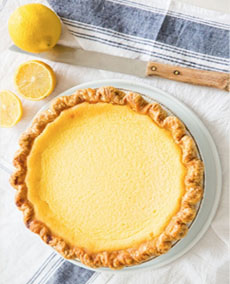
Chess pie has a cornmeal crust. Photo courtesy Good Eggs | SF. |
CHIFFON PIE
Egg whites and gelatin are incorporated into a custard base to provide a lighter, fluffier filling than custard pie or cream pie. Examples include chocolate chiffon, coffee chiffon, lemon, lime, orange, and pumpkin chiffon pie. For the holidays, chiffon candy pie with crushed peppermint stick candy and eggnog chiffon pie are popular. The recipe was invented by Monroe Boston Strause of Los Angeles. In his 1939 cookbook, Pie Marches On, he also lays claim to inventing the black-bottom pie.
See also chiffon cake.
CHOCOLATE SILK PIE
See silk pie.
|
|
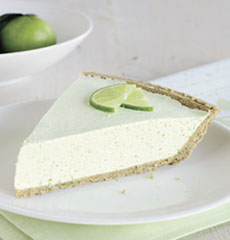
Lime chiffon pie Photo courtesy Kraft. |
CHOUX PASTE or CHOUX PASTRY
See pâte à choux.
CHOUQUETTE
Choux pastry is used to make cream puffs, eclairs, and other pastries. When the dough is simply baked with sanding sugar, it is known as a chouquette or sugar puff. puffs of choux pastry, sprinkled with coarse sugar—very popular with French children.
|
|
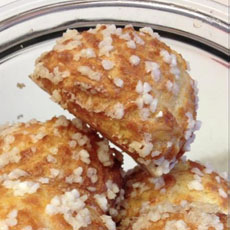
Chouquettes. Photo courtesy Mille Feuille Bakery | New York City. |
CINNAMON ROLLS
A sweet roll or yeast pastry made of layers of flaky pastry and rolled with a cinnamon and sugar filling, and often raisins and nuts. It is topped with a sticky vanilla icing or glaze. (See photo at right.) See also viennoiserie.
|
|
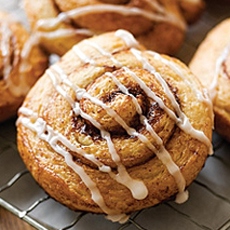
Cinnamon rolls available from MackenzieLtd.com. |
CLAFOUTIS or CLAFOUTI
Clafoutis is a type of cherry tart with pockets of fruit in a baked flan (custard) base. The fruit is covered with a thick batter and baked until puffy. The recipe originated in the Limousin region of France, where tart griotte black cherries were plentiful. Red cherries can also be used. When other kinds of fruit are used instead of cherries—apples, berries, plums, etc.—the dish is properly called a flaugnarde. The dish’s name derives from the old Occitan language of southern France: clafotís is derived from the verb clafir, meaning “to fill” (i.e., the batter is filled with cherries). It spread to other parts of France in the 19th century. Clafoutis can be served hot or cold. Here’s a recipe from Foodbeam.com.
|
|
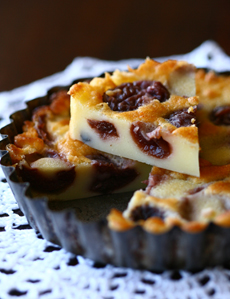
Cherry clafoutis. Photo courtesy Foodbeam.com. |
COBBLER
A cobbler is a cooked fruit dish, but the topping is different from other cooked fruit dishes. A crisp or crumble has a crumb topping (see below). Although some might see the cobbler as a crustless pie or “spoon pie” (a fruit pie with a filling so juicy it should be eaten with a spoon instead of a fork), it is often classified as a cake. Fruit is baked in a baking dish or casserole, then shortcake batter or biscuit dough is dropped onto the fruit before baking. The dish got its name because the lumps of cooked dough resembled cobblestones.
|
|
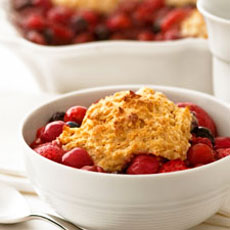
Mixed berry and cherry cobbler. Photo courtesy of USACherries.com. |
Related desserts include:
- Betty, crisp topped with buttered bread crumbs instead of streusel. Some later recipes substitute graham cracker crumbs.
- Buckle, a baked, bottom cake-like layer with the fruit mixed in, topped with a crumb layer (alternatively, the cake, fruit, and crumbs can be three separate layers).
- Crisp, baked fruit filling covered with a crunchy topping, which is crumbled over the top.
- Crumble, the British word for crisp.
- Grunt, a spoon pie with biscuit dough on top of stewed fruit (fruit which is steamed, not baked).
- Pandowdy or pan dowdy, a spoon pie with a rolled top crust that is broken up to allow the juices to come through.
- Slump, another word for grunt, which can be baked or steamed, and can be made upside down.
COCKTAIL PASTRIES
Hors d’oeuvres that include benne pastries (dough mixed with brown sesame seeds and Worcestershire sauce), cheese sticks, mini tarts and quiches, pinwheels (rolled pastry with various fillings (anchovy paste, blue cheese, deviled ham, mushroom) and miniature turnovers.
COFFEE PASTRY
Plain pastry to which a tablespoon of instant coffee is added. Ideal for cream pies.
CONDÉS
Strips of plain pastry or puff pastry, topped with a glaze of sugar and chopped almonds, and sprinkled with confectioner’s sugar.
CONFECTIONERS’ CUSTARD
Crème pâtissière or pastry cream.
CONFECTIONERS’ SUGAR or POWDERED SUGAR or 10x SUGAR
Confectioners’ sugar, also known as icing sugar, is a very finely-ground form of granulated sugar with the consistency of talcum powder. It dissolves quickly to make icing and is used to dust a powdery garnish onto unfrosted cakes. 10x refers to the number of times the sugar is processed to produce fine powder. Commercial brands of powdered sugar are generally mixed with cornstarch, wheat flour, or calcium phosphate to improve their flowing ability, which is why it is not used to sweeten beverages. You can make powdered sugar by grinding table sugar in a coffee grinder. See our Sugar Glossary for more types of sugar.
|
|
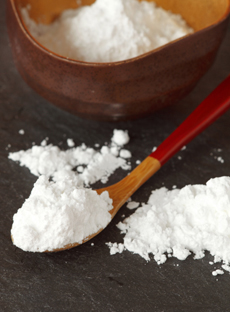
Confectioner’s sugar. Photo by Katharine Pollak | THE NIBBLE. |
COOKIE CRUST
Bottom and top crusts can be made from cookie crumbs: chocolate and vanilla wafers, ginger snaps, graham crackers, and Oreos are popular examples.
COTTAGE CHEESE PIE
A cheesecake made with cottage cheese, often made in a crumb pie shell. By the way: Cheesecake is not a cake. It is a pie filled with cheese-flavored custard.
COTTAGE PIE
A shepherd’s pie with a bottom crust, this traditional British dish serves up slow-roasted beef in gravy (season yours with garlic and mushrooms). Like shepherd’s pie, the top crust is made of mashed potatoes, browned until they are crispy.
|
|
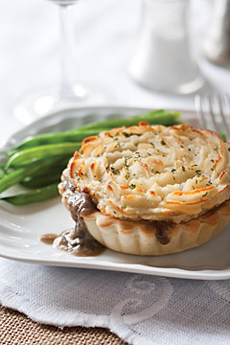
Cottage pie (photo © MackenzieLtd).
|
CREAM HORN
A cream horn is an individual “cornucopia” made from puff pastry that is baked, cooled, and filled with whipped cream or custard. The horn is garnished with cascading cut fruit and dusted with powdered sugar.
Here’s the recipe for the pastry in the photo.
|
|

Cream horn (photo © 2 Bliss Baking). |
CREAM ROLL
A cream horn is a sausage-shaped pastry filled with custard and sprinkled with powdered sugar. The ends are typically garnished with chocolate sprinkles.
A cream roll is a common term, similar to jelly roll or Swiss roll, for a sweet, rolled sponge cake with a filling like whipped cream or jam. The terms are often used interchangeably, though the broader term roulade can also refer to savory rolled dishes or pastries made with different types of dough, making it a more general category that includes the sweet rolled cake.
|
|

Cottage pie. Photo courtesy of MackenzieLtd.com. |
CREAM PIE or CREME PIE
A plain pastry or crumb pastry shell with a pudding filling (butterscotch, chocolate, frangipane, and vanilla are most common). Try a banana cream pie, a coconut cream pie, or a strawberry or raspberry cream pie.
What’s the difference between cream and creme? Just the spelling. Creme is an Americanization of the French word for cream, crème (pronounced KREHM), most likely adapted to make the dish sound more special. But why mispronounce another language’s word for cream? Unless it’s a French recipe, such as Coeur à la Crème, stick to cream.
Also see creme pie, below.
|
|
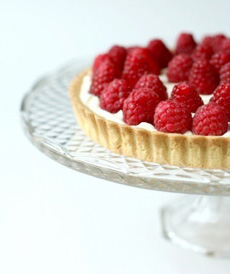
Raspberry cream pie: Here’s the recipe. Photo by Amber B | IST. |
CREAM PUFF
Of those two pastries that people consider siblings, the cream puff and the éclair, the cream puff is the elder, dating back to the late 16th century. It is believed to have originated in Italy with the head chef of Caterina de’ Medici, named Panterelli, who invented a dough he called pâte à Panterelli, later known as pâte à Popelin. Popelins were cakes made in the shape of large puffs. When Caterina moved to France to marry Henry, Duke of Orléans, her court included her chefs. The pastry was later perfected in the early 19th century by Jean Avice, a pastry chef at M. Bailly in Paris (famed pâtissier Sylvain Bailly had a shop near the Palais-Royal).
|
|

Cream puff with a custard filling and powdered sugar dusting. Photo courtesy American Egg Board. |
Perfected by Avice and later by the great French chef and innovator Marie Antoine Carême, who was trained by Avice, this dough became the same as today’s pâté a choux. The elongated éclair did not appear until 200 years later, in the late 18th century. Both are made of pâte à choux (pot-ah-shoo, not pâté). Originally, the cream puff was filled with whipped cream and served plain (or later, dusted with powdered sugar). Now, the round pastry, which is piped from a bag and baked, is often halved, as in the photo at right. Profiteroles, cream puffs stuffed with ice cream and topped with chocolate sauce, are a 20th-century dish. Today, both can be prepared in any way that the pastry chef can conceive, from pistachio whipped cream and glaze to saffron custard with caramel glaze to blueberry jam with cassis whipped cream and cassis glaze. Some cream puffs have chocolate-glazed tops, similar to the éclair. Here’s a recipe for cream puffs and detailed instructions on how to make pâte à choux.
National Cream Puff Day is celebrated on January 2nd.
CRÈME PÂTISSIÈRE or PASTRY CREAM
Crème pâtissière, pastry cream, is a stirred custard (egg yolks and sugar with milk and/or cream) thickened with cornstarch or flour and typically flavored with vanilla (although other flavors can be used). See crème pâtissière in the photo of the cream puff, above. Crème pâtissière is the same recipe as crème anglaise, but the addition of the starch gives it the stability to be brought to a boil. It is used to fill éclairs and other pastries; inside fresh fruit tarts and flans, to fill cakes (it is added to buttercream to make mousseline filling for cake and pastry), etc. With the addition of beaten egg whites, it becomes crème Saint-Honoré, a filling for cream puffs. Here’s a recipe. You can see a photo of it in the picture of the cream puff, immediately above.
CREME PIE or CREAM PIE
“Creme” is an Americanization of the French word for cream, crème (pronounced KREHM). It has been mis-adapted in the U.S. to make the dish seem more special. But spelling it “creme” and pronouncing it “cream” is just wrong. Why use a word from another language unless you pronounce it the correct way?
Best advice: If it’s American, use cream, e.g., coconut cream pie. If it’s French, e.g., crème brûlée, use the accent mark and pronounce it “krehm.” Also see cream pie.
A cream pie can be as simple as the cream filling only, or ornate like the Bavarian cream pie in the photo.
|
|

A Bavarian cream pie is laden with different fruits (photo © J. Java | Fotolia). |
While there is no generic “cream pie” holiday, there are National Raspberry Cream Pie Day on August 1, National Strawberry Cream Pie Day on September 28, and National Bavarian Cream Pie Day on November 27. Plus, as a bonus, National Ice Cream Pie Day on August 18.
As noted on page 1 of this glossary, there are 31 pie holidays.
CRÈME PRALINÉE
Crème pralinée is crème pâtissière flavored with praline powder. It is used to fill pastries.
|
CRISP or CRUMBLE
A crisp is a deep-dish fruit dessert made with a crumb or streusel topping and baked. The British term is crumble. A cobbler has a pastry top instead of a crumb top. Also see betty.
Some people define a crisp as having a crunchy, oat-based streusel topping, sometimes with nuts added for texture.
Crumble can have a flour-and-butter streusel topping that is softer and more crumbly.
Here’s the difference between a betty, bird’s nest pudding, buckle, cobbler, crisp, crow’s nest pudding, crumble, grump, pandowdy, and more.
|
|

Mixed berry crisp (photo © Good Eggs). |
CROQUILLANT or CROUSTILLANT or CROQUANT
All three words mean crispy and are usually used interchangeably. The pastry comprises crunchy balls of yeast dough, which can be sweet or savory; a more elegant rendition of “doughnut holes.” The name comes from croquer, the French verb “to crunch” or “to be crunchy.”
Craquelin is a type of sweet, cookie-like topping for choux pastry. It is similar in texture to croquillant but is a different product. It is typically added on top of raw choux pastry to produce pastry puffs with a crackly appearance and crunchy texture.
|
|

Croquillants from FinancierPastries.com. |
| |
|
|
CROQUE EM BOUCH
A traditional French wedding cake in the shape of a large cone, constructed of small choux puffs filled with vanilla pastry cream. The puffs are held together by caramelized sugar and finished with a web of caramel. Decorations such as candied almonds, flowers, or ribbons may adorn the cone as well. The cone usually rests on a base made from nougatine, an edible mixture of caramelized sugar and sliced almonds. Croque em bouche is also traditionally served during baptisms and other special occasions. The name means “cracks in the mouth,” which is what the caramelized sugar does!
CROSTATA
A crostata is a rustic style of tart baked free form rather than in a pan or mold. The pastry is rolled into a round circle, the filling is piled into the middle, and the edges of the dough are folded up over the filling. The French word is galette.
|
|
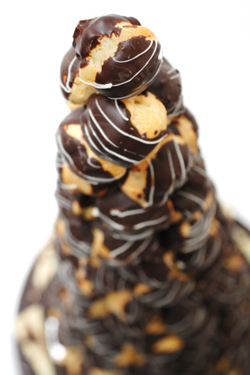
A towering croque em bouche, here covered in chocolate instead of caramel. Photo by Creacart | IST. |
CROUSTADE
Croustade is the French culinary term for crust or pie crust of any type. See crust below.
CRUMBLE PIE
See streusel.
CRUMB PASTRY
A crust made of cookie crumbs or bread crumbs. See cookie crust.
CRUST
The thin layer of pastry covering, lining, and topping a pie. (Note: This term has other meanings with other types of food, e.g., bread crust and salt crust.) Pie crusts are usually made of flaky pastry or puff pastry, but crusts are also made from bread, cookie or cracker crumbs, crushed nuts, mashed or sliced potato, meringue, rice, semolina, shortbread, and vermicelli. See pastry types. See the pie crust entry for the five types of pie crust.
CUSTARD
A sweet or savory mixture of milk and eggs that can either be baked or stirred on the stovetop. Stirred custards are softer than baked custards and can be used as a sauce (or the base for ice cream). Custards require slow cooking and gentle heat in order to prevent separation (curdling); stirred custards are generally made in a double boiler, and baked custards in a water bath. Custards may be flavored. See our Custard Glossary.
CUSTARD PIE or CUSTARD TART
Custard is a combination of milk or cream plus egg yolks and flavoring, and can be baked in a pie or tart shell. Variations include caramel custard pie and coconut custard pie. Pumpkin pie is a pumpkin-flavored custard; cheesecake is a custard pie flavored with cheese. A Key lime tart is flavored with Key lime juice and often, the zest.
|
|
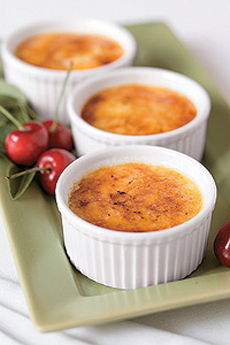
Crème brûlée, custard with a caramelized top, is available from MackenzieLtd.com. |
Continue To The Next Page: Pastry Terms D To F
Return To The Article Index Above

|




